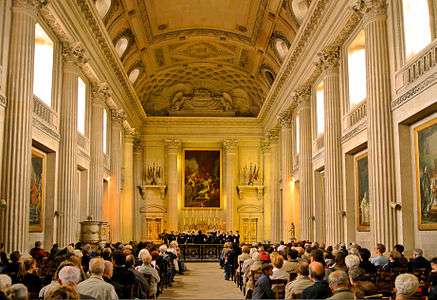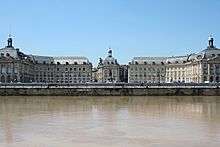Ange-Jacques Gabriel
| Ange-Jacques Gabriel | |
|---|---|
 Ange Jacques Gabriel by Jean-Baptiste Greuze | |
| Born |
October 23, 1698 Paris, France |
| Died |
January 4, 1782 Paris, France |
| Occupation | Architect |
| Parent(s) | Jacques Gabriel |
Ange-Jacques Gabriel (23 October 1698 – 4 January 1782) was the principal architect of King Louis XV of France. His major works included the Place de la Concorde, the École Militaire, and the Petit Trianon and opera theater at the Palace of Versailles. His style was a careful balance between French Baroque architecture and French neoclassicism.[1]
Biography
Early life and career
Ange-Jacques Gabriel was born on October 23, 1698 to a famous Parisian family of architects, and was connected by marriage with another celebrated architect of the time, François Mansart. His grandfather was an architect, and his father, Jacques Gabriel (1667-1742) received the title of Controller of the Buildings of the King at the age twenty-one. His father's major projects included the Hotel de Ville of Rennes and the Place Royale (now Place de la Bourse) in Bordeaux. The young Ange-Jacques became a member of the Académie royale d'architecture in 1728, and assisted his father on the Place de la Bourse. He became the principal assistant to his father as Premier Architecte at the Versailles from 1735 and, after his father's death, succeeded him as chief architect of the King.[2]
In his new position He served the supervision of two successive Directors of the Buildings of the King, Tournehem and Abel-François Poisson, the Marquis de Marigny, the brother of the King's mistress and cultural advisor, Madame de Pompadour.[3]
Place Louis XV (now Place de la Concorde)
 The Place Louis XV in about 1775
The Place Louis XV in about 1775
The Place Louis XV, today's Place de la Concorde, was the first major project undertaken by Gabriel, in 1748. He was asked to find a compromise between several competing plans for the development of the marshy land between the gates of the Tuileries Palace gardens and the new Champs-Elysees. The land was donated by the King. Gabriel took elements of several different plans, being careful leave the view toward the Seine open, and to preserve unobstructed the long axis between the Tuileries and the Champs-Elysees. He created a new north-south axis, connecting the Place with the new Madeleine church, under construction, and two symmetrical palace-on the north side of the square, on either side of Rue Rye Royale. The facades of the palaces, with rows of Corinthian columns, were modeled after the colonnades of the Louvre. The centerpiece of the square was an equestrian statue of Louis XV. The project was finalized in 1754 and was completed in 1763. The statue of Louis XV was removed during the French Revolution, and the obelisk, statues and fountains were added in the 19th century.[4]
Ecole Militaire
 Gabriel's plan for the Ecole Militaire
Gabriel's plan for the Ecole Militaire The Ecole Militaire
The Ecole Militaire Chapel of Saint Louis
Chapel of Saint Louis
Louis XV decided in 1751 to create the Ecole Militaire, the first French military academy, to train five hundred young men from poor noble families "gentlemen" in the art of warfare. The site chosen was next to the plain of Grenelle, on the left bank to the west of the city center. Gabriel's plan called for a "chateau" with two wings flanking a central pavilion with a dome, similar to that of the Louvre. The building featured a facade with a colonnade of the Doric order, and to the rear had a large courtyard with a facade of superimposed orders of columns, opening onto Place Fontenoy, A chapel was artfully integrated into the architecture of the main building. The interior featured a lavishly-decorated salon, now the Salle des Marechals, connected to the grand floor by a majestic ramp, and the Chapel of Louis IX, or Saint Louis, the patron saint of the Army. Two additional wings along Avenue de la Motte-Piquet were added in the 19th century.[5]
The Petit Trianon
 West facade of the Petit Trianon
West facade of the Petit Trianon Aerial view of the Petit Trianon and its small park
Aerial view of the Petit Trianon and its small park
At the request of Madame Pompadour, Gabriel had made plans for a smaller pavilion at Versailles away from the main palace and the Trianon. With the end of the expensive Seven Years' War Louis XV approved the plans, and between 1763 and 1768 the small chateau was constructed. The building was cubic, and each facade was different; each was decorated with pilasters, columns and pediments in perfect proportion and harmony. The facades of the Petit Trianon represented in its most pure form the emerging style of Neoclassicism in France.[6]
Royal Opera of Versailles
_-_DSC_0921.jpg) Foyer of the Royal Opera
Foyer of the Royal Opera The Royal Opera during the celebration of the marriage of Louis XVI and Marie-Antoinette (1770)
The Royal Opera during the celebration of the marriage of Louis XVI and Marie-Antoinette (1770) Royal box
Royal box Stage of the Royal Opera
Stage of the Royal Opera
Much of his attention was devoted to modifications of the Palace of Versailles desired by Louis XV. The palace lacked a proper opera theater; a theater had been commanded under Louis XIV in 1682 for the end of the North Wing but the project had been put on hold due to its cost of the King's wars and the complexity of meeting the needs of the Court. Gabriel made a new proposal for the same sit in 1748, but it was also put on hold due to the cost. occupied himself with numerous modifications to the exterior of the Palace, notably the completion and extension of the North Wing, following closely the original designs of Mansard This was completed in 1764.[7]
The Opera project was revived in 1765 and was accelerated in 1770 for the celebrations of the marriage of the Dauphin, the future Louis XVI, to the Archiduchesse of Austria, Marie-Antoinette. To finish the project quickly and at lower cost, the theater was made entirely of wood, painted to resemble marble, but also giving it exceptionally good acoustics. The theater was in blue and gold, made in shape of truncated ellipse or oval, surrounded by tiers of boxes, decorated with carved and gilded wood, illuminated by three thousand candles whose light was reflected in mirrors. By this time Louis XV had a new mistress, Madame Du Barry, and the royal box, the size of three ordinary boxes, had a grill to protect their privacy. Sculptures by Augustin Pajou and a painted ceiling by Louis Jean-Jacques Durameau completed the interior. Gabriel and his chief architectural engineer, Blaise Arnaud, studied installing a mechanism to hoist the floor of the theater up to the level of the stage, to create an enormous ballroom, but this was never completed.[7]
Death
His final projects were the completion of the facades of the buildings he designed for the Place de la Concorde; the former Hôtel de Coislin, and the Hotel Crillon, finished in 1770. and the building of what today is the Hotel de la Marine, the headquarters of the French Navy until 2016, which was finished in 1774, He died in Paris in 1782.
Style
His sober rationality in planning and detail promoted the transition from Rococo to Neoclasscism. He was not especially known for boldness or originality; borrowing extensively from the French classicism and early classical models, particularly from the Louvre. He was known for his craftsmanship, his ability to balance the animation of the Baroque style with the more restrained neoclassicism, the proportions and balance and careful detail of his buildings, and his ability to create dramatic and harmonious ensembles of monumental buildings, as he did in the Place de la Concorde. [8]
Major works


- Place de la Bourse, Bordeaux, 1730-1775, begun by his father, after 1740 completed by Gabriel
- Extension and transformations at the Château de Choisy, 1740–1777
- Château de Compiègne, 1750 onwards
- The Pavillon du Butard, 1750 at La Celle-Saint-Cloud.
- Place de la Bourse, Bordeaux, 1755 (as Place Royale)
- Extension of the Château de Menars (Loir-et-Cher), 1760–1764, for Madame de Pompadour
- Petit Trianon, at Versailles, 1762 to 1768
- L'École Militaire on the Champ de Mars, Paris
- L'Opéra at the Château de Versailles, 1769–70
- Place de la Concorde (as Place Louis XV), 1772
- Hôtel de la Marine, Place de la Concorde, 1775
- Hôtel de Crillon, Place de la Concorde
See also
Notes
- ↑ Gallet (1999), pp. 256-57
- ↑ Gallet (1999), pp. 256-57
- ↑ Gallet (1999), pp. 256-57
- ↑ Gallet (1999), pp. 257-258
- ↑ Gallet (1999), pp. 259-260
- ↑ Gallet (1999), page 264.
- 1 2 Saule 2013, p. 60.
- ↑ Gallet 1999, p. 264.
Bibliography
- Braham, Allan (1980). The Architecture of the French Enlightenment, pp. 38–44. Berkeley: University of California Press. ISBN 9780520067394.
- Gallet, Michel (1999). Anges Jacques Gabriel. Dictionnaire des Architectes, pp. 256–264. Encyclopaedia Universalis, Paris. ISBN 2-226-10952-8
- Gallet, Michel; Bottineau, Yves (1982). Les Gabriel. Paris: Picard. ISBN 9782708400863.
- Gallet, Michel (1995). Les architectes parisiens du XVIIIe siècle: dictionnaire biographique et critique, pp. 212–224. Paris: Editions Mengès. ISBN 9782856203705.
- Kalnein, Wend von (1995). Architecture in France in the Eighteenth Century, pp. 145–160. New Haven: Yale University Press. ISBN 9780300060133.
- Saule, Beatrix (2013). Versailles - The Chateau, the gardens, the Trianons, Paris, Art Lys. ISBN 9782711873395
- Tadgell, Christopher (1978). Ange-Jacques Gabriel (in English). London: A. Zwemmer. ISBN 9780302027813.
- Tadgell, Christopher (1982). "Gabriel, Ange Jacques", vol. 2, pp. 133–144, in Macmillan Encyclopedia of Architects, 4 volumes, edited by Adolf K. Placzek. London: The Free Press. ISBN 9780029250006.
- Tadgell, Christopher (1996). "Gabriel: (3) Ange-Jacques Gabriel", vol. 11, pp. 882–884, in The Dictionary of Art, 34 volumes, edited by Jane Turner. New York: Grove. ISBN 9781884446009. Also at Oxford Art Online (subscription required).
External links
| Wikimedia Commons has media related to Ange-Jacques Gabriel. |
- Ange-Jacques Gabriel at Great Buildings Online